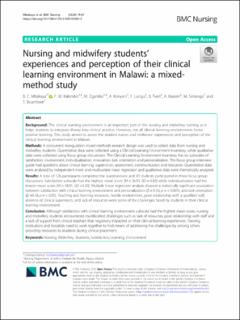| dc.description.abstract | Background: The clinical learning environment is an important part of the nursing and midwifery training as it helps students to integrate theory into clinical practice. However, not all clinical learning environments foster positive learning. This study aimed to assess the student nurses and midwives’ experiences and perception of the clinical learning environment in Malawi.
Methods: A concurrent triangulation mixed methods research design was used to collect data from nursing and midwifery students. Quantitative data were collected using a Clinical Learning Environment Inventory, while qualitative data were collected using focus group discussions. The Clinical Learning Environment Inventory has six subscales of satisfaction, involvement, individualisation, innovation, task orientation and personalisation. The focus group interview guide had questions about clinical learning, supervision, assessment, communication and resources. Quantitative data were analysed by independent t-test and multivariate linear regression and qualitative data were thematically analysed.
Results: A total of 126 participants completed the questionnaire and 30 students participated in three focus group discussions. Satisfaction subscale had the highest mean score (M = 26.93, SD = 4.82) while individualisation had the lowest mean score (M = 18.01, SD =3.50). Multiple linear regression analysis showed a statistically significant association between satisfaction with clinical learning environment and personalization (β = 0.50, p = < 0.001), and task orientation (β =0.16 p = < 0.05). Teaching and learning resources, hostile environment, poor relationship with a qualified staff, absence of clinical supervisors, and lack of resources were some of the challenges faced by students in their clinical learning environment.
Conclusion: Although satisfaction with clinical learning environment subscale had the highest mean score, nursing and midwifery students encountered multifaceted challenges such as lack of resources, poor relationship with staff and a lack of support from clinical teachers that negatively impacted on their clinical learning experiences. Training institutions and hospitals need to work together to find means of addressing the challenges by among others providing resources to students during clinical placement. | en_US |
